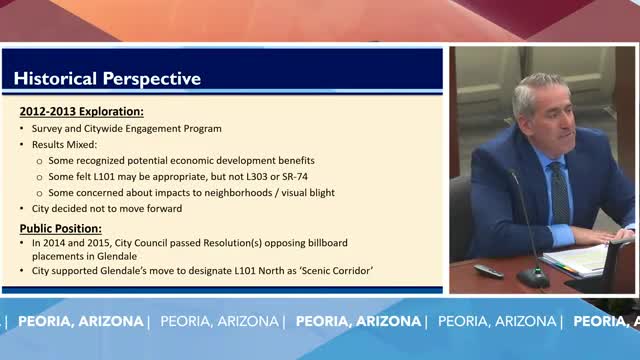Peoria Council discusses digital billboard placements and community concerns
April 30, 2025 | Peoria, Maricopa County, Arizona
Thanks to Scribe from Workplace AI , all articles about Arizona are free for you to enjoy throughout 2025!

This article was created by AI using a video recording of the meeting. It summarizes the key points discussed, but for full details and context, please refer to the video of the full meeting. Link to Full Meeting
City officials presented arguments in favor of digital billboards, noting their potential to attract businesses and generate revenue. Currently, Peoria has 14 static billboards, with one company owning 13 of them. The council discussed the possibility of a "swap-out" program, where older billboards could be replaced with digital versions, potentially improving the overall appearance and functionality of signage in the area.
Concerns were raised regarding the impact of digital billboards on residential neighborhoods, particularly regarding visual blight and driver distraction. Council members emphasized the importance of maintaining adequate setbacks from residential areas and ensuring that any new signage adheres to strict design and operational standards. The minimum state requirement for setbacks is currently 500 feet from residential properties, but many council members expressed a desire to establish even greater distances to protect community interests.
The council also explored the legal implications of allowing digital billboards on public property, including the potential for revenue generation through lease agreements. However, they acknowledged the challenges of controlling the content displayed on these billboards, as they would be subject to free speech laws.
As the meeting concluded, council members expressed a consensus on the need for further exploration of the digital billboard initiative. They agreed to gather more information and community feedback before moving forward with any formal proposals. The discussion underscored the city's commitment to balancing economic development with the preservation of community character and safety.
Converted from City Council Meetings - 02/11/2025 meeting on April 30, 2025
Link to Full Meeting
Comments
View full meeting
This article is based on a recent meeting—watch the full video and explore the complete transcript for deeper insights into the discussion.
View full meeting
